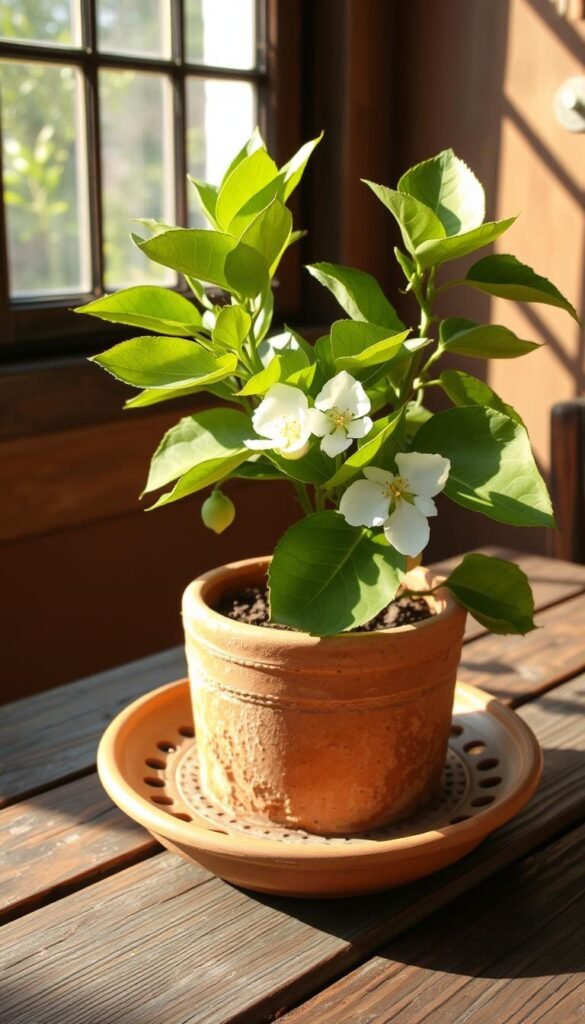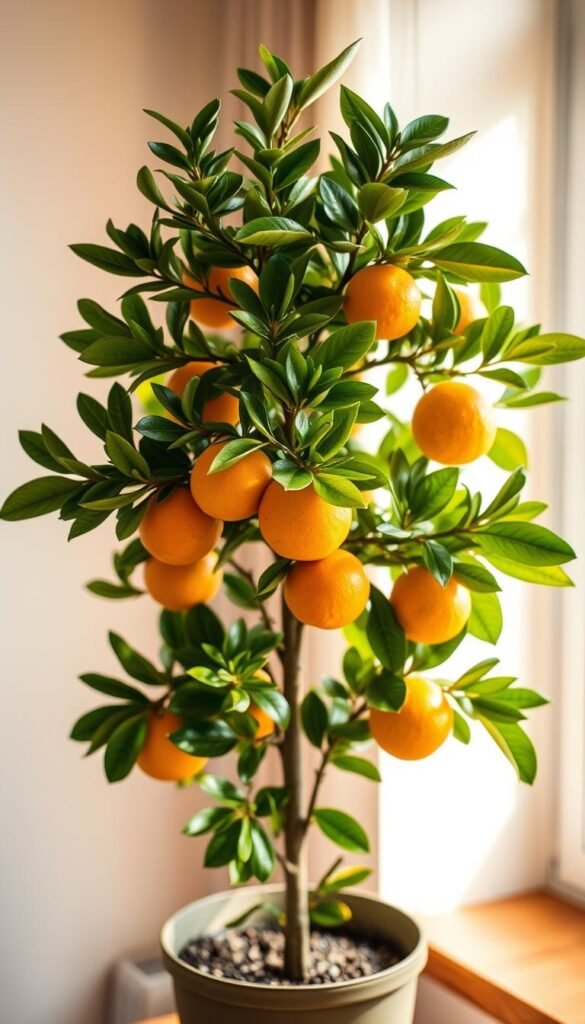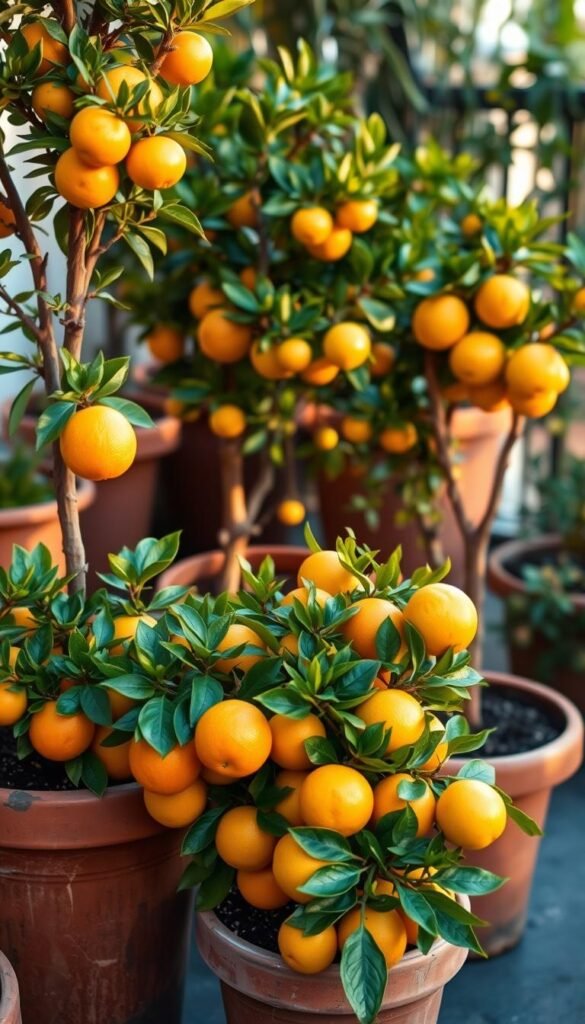Who says you need a sprawling backyard to enjoy homegrown citrus? With the right approach, even a sunny balcony or paved patio can become a productive oasis. Container gardening opens doors for urban dwellers or anyone dealing with poor native soil, letting you control every aspect of your plant’s environment.
Starting with a 10-14″ pot gives young saplings room to establish roots without drowning in excess soil. Always choose containers with multiple drainage holes—this prevents waterlogged roots, a common issue in poorly designed planters. Pair this with a lightweight potting mix rich in organic matter, and you’ve laid the groundwork for success.
Sunlight is non-negotiable: aim for at least 6-8 hours daily. Rotate your pots weekly to ensure even growth, and monitor moisture levels closely. A simple finger test (dry top inch = time to water) keeps things stress-free. For those in colder zones, moving plants indoors during frosty months preserves your hard work.
New to small-space gardening? Try beginner-friendly options like Eureka lemons or Bearss limes. These varieties adapt well to container life and reward you with fragrant blossoms before fruiting. With attentive care, you’ll soon be harvesting sun-warmed citrus right outside your door!
Understanding Citrus Growth in Containers

Urban spaces and small yards can still produce vibrant citrus harvests with smart container strategies. By embracing portable planters, you gain precise control over your tree’s environment while saving valuable square footage.
Exploring the Benefits of Container Growing
Potted citrus offers unmatched flexibility. Move plants to chase sunlight or shield them from harsh weather. You’ll also customize soil blends to match your tree’s needs—sandy mixes prevent soggy roots, while compost-rich blends boost nutrients.
| Factor | Container Growing | Ground Planting |
|---|---|---|
| Mobility | Rotate for light/shade | Fixed location |
| Soil Control | Tailor drainage & pH | Native soil only |
| Space Needed | Balcony-friendly | Requires yard space |
Adapting Your Patio to a Citrus Haven
Concrete surfaces and walls reflect warmth, creating ideal microclimates. Position pots where they’ll get 8+ hours of direct sunlight daily. If natural light falls short, supplement with LED grow lights.
Follow a container gardening guide to avoid overwatering. Check soil moisture weekly—deep watering every 5-7 days works for most varieties. With time, you’ll master the rhythm of care for lush flowers and fruit.
Selecting Containers, Location, and Lighting for Your Citrus

The secret to vibrant container-grown citrus lies in three elements: smart pot choices, strategic placement, and light management. Get these right, and you’ll create a thriving environment even in limited spaces.
Choosing the Ideal Pot with Proper Drainage
Start with a 10-14″ container for young citrus trees, upgrading to 16-20″ as they mature. Clay pots breathe better but dry faster, while plastic retains moisture. Whichever you pick, ensure at least 3 drainage holes.
Boost drainage by adding pebbles at the base or using a double-pot system. This simple trick prevents root rot—a key issue many gardeners face. Pair your pot with a lightweight mix containing perlite and compost for optimal root health.
| Pot Material | Pros | Cons |
|---|---|---|
| Terracotta | Natural aeration | Heavy; dries quickly |
| Plastic | Lightweight | Less breathable |
Maximizing Direct Sunlight and Creating a Warm Microclimate
Citrus needs 8+ hours of daily sun. Place pots near south-facing walls that reflect heat. If your space gets less light, use full-spectrum LEDs for 4 extra hours daily.
Test your patio’s microclimate by monitoring morning vs afternoon sun patterns. Rotate trees weekly for even growth. Remember—proper setup now means fewer common container mistakes later!
Compact Fruit Trees: Growing Citrus in Patio Pots

Transforming your patio into a citrus paradise starts with mastering the art of potting. Let’s break down the essentials for healthy growth, from soil prep to seasonal adjustments.
Step-by-Step Planting and Potting Techniques
Begin by tilting the container sideways and gently sliding out your plant. Use clean pruners to trim any dark or tangled roots, leaving healthy white ones intact. Position the tree so its crown sits 1″ above the soil line—this prevents rot.
- Fill 1/3 of your new pot with a mix of perlite, compost, and peat moss
- Center the root ball, spreading branches evenly
- Backfill soil, tamping lightly to remove air pockets
| Fertilizer Type | Application Frequency | Key Benefits |
|---|---|---|
| Slow-Release Granules | Every 3 months | Steady nutrient supply |
| Liquid Citrus Feed | Biweekly | Quick absorption |
Watering, Fertilizing, and Root Care Tips
Soak the soil thoroughly after repotting until water flows freely from drainage holes. Wait 48 hours before adding fertilizer to avoid shocking tender roots. Stake young plants for support using soft ties.
Check moisture weekly—if the top 2″ feels dry, water deeply. Rotate your containers monthly to ensure even light exposure. Remember: annual repotting prevents root-bound issues and maintains vigorous growth.
Indoor Citrus Care and Seasonal Transitions

When temperatures dip below freezing, your container-grown citrus needs protection. Moving plants indoors preserves their health while maintaining year-round growth potential. This seasonal shift requires careful planning to mimic outdoor conditions.
How to Transition Citrus Indoors During Cold Weather
Start the move before frost hits. Gradually reduce sunlight exposure over 7-10 days to prevent shock. Place your tree in bright, indirect light first—a shaded porch works well.
Check leaves and branches for pests before bringing them inside. Wipe down with neem oil if needed. Once indoors, maintain temperatures between 55-68°F for optimal dormancy.
| Outdoor Care | Indoor Care |
|---|---|
| Daily direct sunlight | Supplemental grow lights |
| Natural rainfall | Controlled watering |
| Seasonal fertilizer | Reduced feeding schedule |
Using Grow Lights and Managing Humidity Levels
In northern climates, provide 12-14 hours of artificial light daily. Full-spectrum LEDs placed 12″ above foliage mimic summer intensity. Rotate plants weekly for even coverage.
Combat dry indoor air by setting pots on trays filled with water and pebbles. Mist leaves every 3-4 days to maintain 40-50% humidity. Reduce watering frequency—let soil dry 2″ deep between sessions.
| Light Type | Daily Hours | Best For |
|---|---|---|
| LED Grow Lights | 12-14 | Energy efficiency |
| Fluorescent | 14-16 | Budget-friendly |
Monitor moisture weekly with a soil probe. Adjust care as seasons change—your citrus will thrive with these tailored indoor strategies!
Optimizing Soil Mix, Fertilizer, and Maintenance

Your citrus container garden thrives or falters beneath the surface—where roots meet soil. Let’s explore how to craft the ideal growing environment and keep your plants flourishing year after year.
Creating the Perfect Soil Blend for Healthy Roots
Citrus roots demand airy, fast-draining soil. Mix 5 parts fine pine bark, 1 part perlite, and 1 part potting soil. This combo mimics their natural habitat while preventing waterlogging.
- Skip gravel layers—they trap moisture instead of improving drainage
- Test drainage: Water should exit pot holes within 10 seconds
- Refresh topsoil annually with compost for nutrient boosts
| Soil Amendment | Purpose |
|---|---|
| Perlite | Improves aeration |
| Pine Bark | Prevents compaction |
| Worm Castings | Adds slow-release nutrients |
Repotting and Maintenance Insights for Long-Term Growth
Upgrade containers when roots peek through drainage holes or circle the pot’s base. Spring is ideal—warmer temps help plants recover faster.
- Water thoroughly 24 hours before repotting
- Prune dead roots with sterilized shears
- Position in new pot 1-2″ higher than before
Feed with slow-release granules every 3 months. For organic options, try fish emulsion or compost tea. Always water before fertilizing to protect roots.
| Fertilizer Type | Best Use |
|---|---|
| Osmocote | Low-maintenance feeding |
| Worm Tea | Monthly root stimulation |
Check root zones annually for pests. Gently loosen compacted soil with a hand fork—this improves oxygen flow. Pair these steps with small-space gardening strategies for maximum patio productivity!
Final Insights for Successful Citrus Container Gardening
Cultivating zesty citrus in containers isn’t just possible—it’s a game-changer for space-savvy gardeners. By focusing on proper drainage, tailored soil blends, and seasonal adjustments, you’ll create an environment where these sun-loving plants thrive.
Start with a pot that allows room for roots to expand, upgrading its size every 2-3 years. Pair this with a well-aerated soil mix to prevent waterlogging—your tree’s health depends on this foundation. Monitor moisture closely, especially when shifting between summer’s heat and winter’s chill.
Adapt your care routine to local climates. Those in cooler zones might need grow lights, while humid areas should watch for fungal issues. As your plant matures, explore pruning guides to shape growth and boost yields.
Remember: consistency wins. Check soil weekly, rotate for even sunlight, and refresh nutrients seasonally. With patience and these strategies, even a modest patio can burst with fresh citrus. Now’s the time to tweak your approach and taste the rewards!






